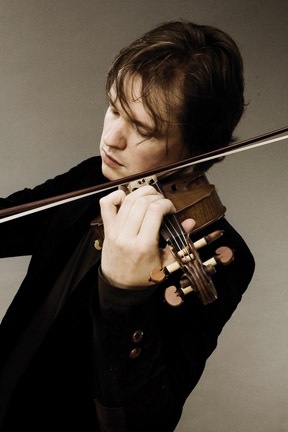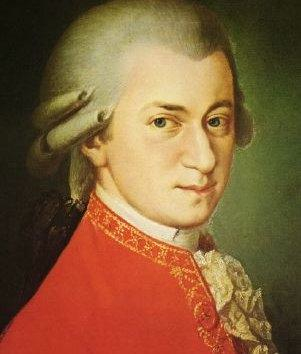The Well-Tempered Ear
Classical music: This weekend’s concerts by the Madison Symphony Orchestra and returning violinist Henning Kraggerud offer a terrific mix of Classical-era Mozart and modernist Shostakovich. Plus, a UW-Madison horn and trombone duo, with electronics, plays a FREE concert tonight.
Leave a Comment
A REMINDER: Tonight, Wednesday, March 6, at 7:30 p.m. in Mills Hall, the duo “Gretzler” — made up of UW-Madison hornist Daniel Grabois (below) and UW-Madison trombonist Mark Hetzler will perform a FREE concert. The new electronica power duo combines the horn and trombone with electronics, both computer- and hardware-based. The program will feature “Volcano Songs” by Meredith Monk; “Available Forms” by Meyer Kupferman; “Videotape” by Radiohead; and “Love Meant Living” Alone by Daniel Grabois.
By Jacob Stockinger
It is exactly my kind of programming: Putting very disparate or contrasting styles side-by-side, and it often proves irresistible.
The Madison Symphony Orchestra’s music director John DeMain (below) has done it before—one of the most memorable examples for me was his combining Haydn cello concerto with a massive Mahler symphony, and the last MSO concert combined Prokofiev and Beethoven. This weekend he is doing is again with the “Champagne and Vodka” program.
This time, Mozart is the champagne and Shostakovich is the vodka. But you don’t even have to be a drinker to get intoxicated by this music.
This weekend, DeMain and the Madison Symphony Orchestra (MSO) team up with the quiet but forceful Norwegian violinist Henning Kraggerud.
Kraggerud (below) will perform Mozart’s Violin Concerto No. 4, the most elegant of the composer’s five violin concertos – Mozart was an excellent violinist as well as keyboardist. They are all relatively early works, full of charm but less dramatic and less dark than many of Mozart’s later and more mature works.
The MSO will open the concert with the lively overture to Mozart’s opera “The Impresario” and conclude with Shostakovich’s powerful Symphony No. 10.
The MSO concerts will take place in Overture Hall at 201 State Street this Friday at 7:30 p.m.; Saturday at 8 p.m.; and Sunday at 2:30 p.m.
Tickets cost $16.50 to $78.50, and are available at www.madisonsymphony.org and through the Overture Center Box Office at 201 State Street, (608) 258-4141. Groups of 15 or more save 25 percent.
Seniors and students save 20 percent, and the MSO’s $10 Student Rush is good for best available seats on the day of the concert. Discounted seats are subject to availability and discounts may not be combined.
Full concert details, music samples and links to buy tickets can be found on the MSO website at http://madisonsymphony.org/kraggerud
For comprehensive but very accessible program notes by MSO trombone player and UW-Whitewater professor J. Michael Allsen, visit:
http://facstaff.uww.edu/allsenj/MSO/NOTES/1213/7.Mar13.html
Allsen (below) will also be giving the free pre-concert talks.
Kraggerud, who is returning to the MSO stage for the third time in just six years, has been praised for his “virtuosity minus theatrics” by the Washington Post, and has gained a reputation as a violinist to watch: “Kraggerud has extraordinary sweetness of tone,” said The Telegraph of London recently, “his sound always dances as much as it sings.”
About the D Major Mozart concerto, Kraggerud said, “The Mozart concerto is one of my favorites. It is like champagne in the bloodstream, so fresh.”
All five of violin concertos by Mozart (below) were written in 1775 when the composer was a teenager. Though they are youthful works, the violin concertos are also worldly, showing the influence of Mozart’s having traveled through much of Europe as a child prodigy, absorbing ideas and influences. The overture that opens the concert is light and comic, an apt introduction.
By contrast, the Shostakovich symphony that closes the March concerts is a late work and was first performed after the death of the ruthless Soviet dictator Josef Stalin, who had threatened the composer many times, in 1953.
The Symphony No. 10 is in many ways the reaction of Shostakovich (below) to Stalin’s death as the tight artistic controls of the 1930s and ‘40s were relaxed. It represents a new beginning, pouring forth all that had been repressed under the dictator’s oppression.
Anyone wishing to share dining and conversation with other music lovers can join Club 501 before any Saturday or Sunday performance. Hosted by members of the Madison Symphony Orchestra League, Club 501 welcomes everyone to the Madison Concourse Hotel’s Dayton Street Grille on concert Saturdays at 6 p.m. and concert Sundays at 12:30 p.m.
Participants receive a generous 20% meal discount and free parking with a validated underground parking ticket. Guests should ask for the Club 501 tables when arriving. Reservations are welcome — but not necessary — at (608) 294-3068.
Tags: Béla Bartók, Brandenburg Concerto, Carl Stamitz, Chicago Symphony Orchestra, Dmitri Shostakovich, Friday, Henning Kraggerud, J.S. Bach, Jacob Stockinger, John DeMain, Madison Symphony Orchestra, Mark Hetzler, Mozart, MSO, Overture Center, Saturday, Sunday, University of Wisconsin–Madison, Violin concerto, Wolfgang Amadeus Mozart
- May 2024
- April 2024
- March 2024
- February 2024
- January 2024
- December 2023
- November 2023
- October 2023
- September 2023
- August 2023
- July 2023
- June 2023
- May 2023
- April 2023
- March 2023
- February 2023
- January 2023
- December 2022
- October 2022
- September 2022
- June 2022
- May 2022
- April 2022
- March 2022
- July 2021
- June 2021
- May 2021
- April 2021
- March 2021
- February 2021
- January 2021
- December 2020
- November 2020
- October 2020
- September 2020
- August 2020
- July 2020
- June 2020
- May 2020
- April 2020
- March 2020
- February 2020
- January 2020
- December 2019
- November 2019
- October 2019
- September 2019
- August 2019
- July 2019
- June 2019
- May 2019
- April 2019
- March 2019
- February 2019
- January 2019
- December 2018
- November 2018
- October 2018
- September 2018
- August 2018
- July 2018
- June 2018
- May 2018
- April 2018
- March 2018
- February 2018
- January 2018
- December 2017
- November 2017
- October 2017
- September 2017
- August 2017
- July 2017
- June 2017
- May 2017
- April 2017
- March 2017
- February 2017
- January 2017
- December 2016
- November 2016
- October 2016
- September 2016
- August 2016
- July 2016
- June 2016
- May 2016
- April 2016
- March 2016
- February 2016
- January 2016
- December 2015
- November 2015
- October 2015
- September 2015
- August 2015
- July 2015
- June 2015
- May 2015
- April 2015
- March 2015
- February 2015
- January 2015
- December 2014
- November 2014
- October 2014
- September 2014
- August 2014
- July 2014
- June 2014
- May 2014
- April 2014
- March 2014
- February 2014
- January 2014
- December 2013
- November 2013
- October 2013
- September 2013
- August 2013
- July 2013
- June 2013
- May 2013
- April 2013
- March 2013
- February 2013
- January 2013
- December 2012
- November 2012
- October 2012
- September 2012
- August 2012
- July 2012
- June 2012
- May 2012
- April 2012
- March 2012
- February 2012
- January 2012
- December 2011
- November 2011
- October 2011
- September 2011
- August 2011
- July 2011
- June 2011
- May 2011
- April 2011
- March 2011
- February 2011
- January 2011
- December 2010
- November 2010
- October 2010
- September 2010
- August 2010
- July 2010
- June 2010
- May 2010
- April 2010
- March 2010
- February 2010
- January 2010
- December 2009
- November 2009
- October 2009
- September 2009
- August 2009
Archives
- 2,491,491 hits
Blog Stats
Recent Comments
| Brian Jefferies on Classical music: A major reass… | |
| welltemperedear on What made Beethoven sick and… | |
| rlhess5d5b7e5dff on What made Beethoven sick and… | |
| welltemperedear on Beethoven’s Ninth turns 200… | |
| Robert Graebner on Beethoven’s Ninth turns 200… |
Tags
#BlogPost #BlogPosting #ChamberMusic #FacebookPost #FacebookPosting #MeadWitterSchoolofMusic #TheEar #UniversityofWisconsin-Madison #YouTubevideo Arts audience Bach Baroque Beethoven blog Cello Chamber music choral music Classical music Compact Disc composer Concert concerto conductor Early music Facebook forward Franz Schubert George Frideric Handel Jacob Stockinger Johannes Brahms Johann Sebastian Bach John DeMain like link Ludwig van Beethoven Madison Madison Opera Madison Symphony Orchestra Mead Witter School of Music Mozart Music New Music New York City NPR opera Orchestra Overture Center performer Pianist Piano post posting program share singer Sonata song soprano String quartet Student symphony tag The Ear United States University of Wisconsin-Madison School of Music University of Wisconsin–Madison Viola Violin vocal music Wisconsin Wisconsin Chamber Orchestra wisconsin public radio Wolfgang Amadeus Mozart YouTube




